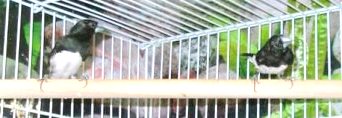
Home |
Articles |
Aviaries |
Breeders |
Cages |
Downloads |
Food |
Getting Started |
Groups |
How To's |
Links |
Photos |
Suppliers |
Webcams |
Sitemap |
Contact |
Benefits of Keeping Records |
Keeping records on the birds you are raising is helpful and useful if you decide to breed them and raise offspring, and if you intend to eventually give or sell any of your birds to other finchkeepers. Read Finch Information Center's excellent banding & record keeping info here If you decide to allow your birds to breed and raise offspring, record-keeping is really important. Registering and closed-banding your baby finches about 10 days after hatch is important if you want to keep track on your birds for later on - to sell to other breeders or for showing in a Finch Show for breeder points. Pet bird keepers may not care if your birds are closed-banded and registered with the National Finch & Softbill Society. Split or "Open" bands are a great way to identify your birds if you are not going to closed-band them within about 8 to 10 days of their hatchdate. The most common uses of split bands is to visually ID which gender your finches are once you have heard the males sing and dance, or sometimes to keep which familiy they came from all one color of band for easy visual ID of birds which are related or not related to one another. You can usually find a vendor at a Bird Mart that carries strings of colored split bands - either solid colors or stripes - and they are usually very inexpensive. Split bands are also available from many vendors online - check: Bird Supply of New Hampshire or Redbird Products Serious birdkeepers will usually request your bird breeding records, if they are breeding certian varieties of finches and seeking to control their own breeding outcomes for various characteristics. This could be feather color, body shape (conformance) eye color, beak color, feather-patterning (varigation) or lack of (clear wing) song quality, song loudness or softness, and others. If you are serious about learning what specific qualities dedicated finch breeders are looking for, a good place to start learning is by reading the NFSS Judge's Handbook 2010 - 4th Edition. The NFSS also maintains a National Census of Finches and Softbills - to track how many and what types of which species of Finch and Softbills are being raised in the USA and Canada and their territories. View the latest NFSS Census results here at http://www.nfss-fss.org/Census/CensusReport.aspx For genetic selection, it is essential to have a basic understanding of various details that comprise the characteristics for which you are breeding. There are websites dedicated to various methods of attaining certain attributes such as feather color combination/feather color placement on Lady Gouldian Finches and Zebra Finches. Garrie Landry is one of the foremost experts with direct years of experience in breeding Society Finches and Zebra Finches and many other types of birds. Visit his aviary site Acadania Aviaries for more detailed information and inspiration for genetic varieties.Here's a tour of his farm that Spring Song Aviary posted on their site when they visited Garrie in Louisiana a few years ago. Related articles: First Steps - before you put male and female finches in the same cage Breeding Reference Articles from JustBirdStuff Finch Breeding template in MS Word Gouldian Breeding template in MS Excel Software Packages for Avian Record Keeping The Varieties and Genetics of the Zebra Finch By Garrie P. Landry
Do you and your family members carry a Pet Emergency Card in your wallet? |

All contents Copyright © Finchfriends.org
Logos and Linked documents property of respective creators
